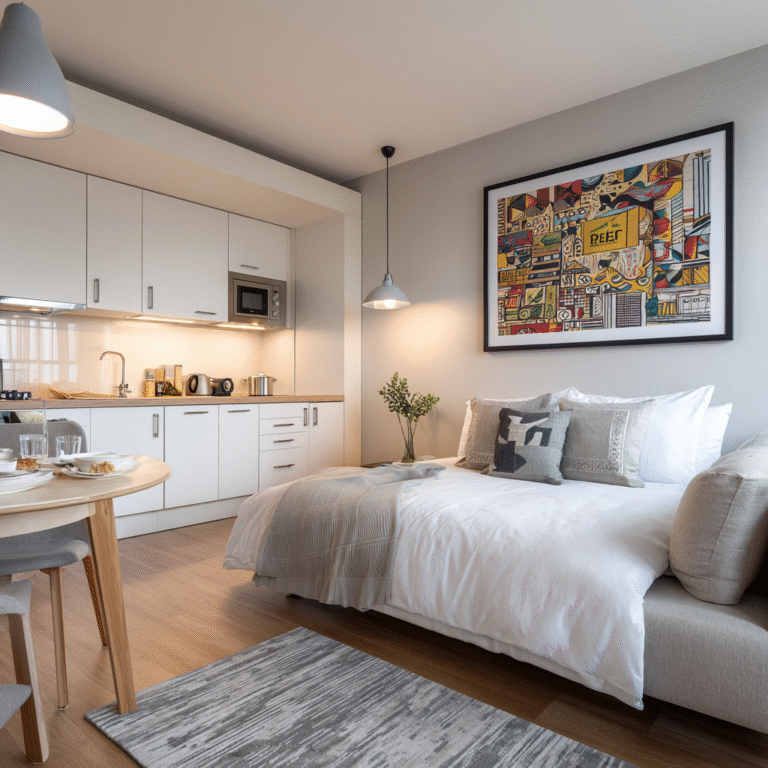Living in a studio apartment under 400 square feet presents unique design challenges that require creative solutions and strategic thinking. The key to success lies in understanding how visual elements can dramatically alter spatial perception, making cramped quarters feel open, organized, and intentionally designed. With the right approach to wall art placement and selection, even the smallest spaces can achieve maximum impact while maintaining functionality.
According to Rently’s 2025 Apartment Design & Decor Trends Report, renters are making more intentional design choices this year, focusing on spaces that feel curated and stylish without clutter. This shift toward purposeful decorating means that budget-conscious renters are seeking affordable posters and wall art that deliver significant visual impact without requiring major renovations or expensive investments. The challenge becomes selecting and positioning these pieces to create the illusion of expanded space while reflecting personal style.
Creating vertical flow and height illusion
The most effective strategy for expanding visual space in tiny studios involves drawing the eye upward through strategic vertical placement of artwork. Position larger statement pieces higher on walls than you might in spacious rooms, creating an upward visual flow that makes ceilings appear taller and rooms feel more expansive. This technique works particularly well when combined with pieces that feature vertical elements like tall trees, architectural photography, or abstract designs with strong vertical lines.
Consider creating a gallery wall that extends from mid-wall height to near the ceiling, using pieces of varying sizes arranged in an ascending pattern. This approach not only maximizes wall space usage but also creates a dynamic focal point that distracts from the room’s compact dimensions. The key is maintaining consistent spacing between pieces while ensuring the arrangement feels intentional rather than cluttered.
When selecting artwork for vertical emphasis, choose pieces with light backgrounds or open compositions that won’t visually weigh down the space. Landscape photography, minimalist line drawings, and botanical prints work exceptionally well for creating this upward momentum while maintaining the clean, curated aesthetic that defines successful small-space design.
The psychology behind vertical placement extends beyond mere visual tricks. Research shows that drawing attention upward activates the same spatial processing mechanisms that make outdoor environments feel expansive. By incorporating tall, narrow formats or creating vertical groupings of smaller pieces, you can trigger these same psychological responses within your compact living space, making the room feel significantly larger than its actual dimensions.
Strategic color psychology and light reflection

Color selection in poster art becomes crucial when working with limited square footage, as certain hues can either expand or contract perceived space. Light, cool colors like soft blues, pale greens, and warm whites reflect natural light and create an airy feeling that makes rooms appear larger. Incorporating artwork with these color palettes, especially pieces with significant white or negative space, helps maintain visual breathing room even when wall space is limited.
Mirror-like effects can be achieved through artwork featuring reflective elements like water scenes, glass architecture, or metallic accents. These pieces bounce available light around the room, creating depth and luminosity that counters the closed-in feeling common in small studios. Position such pieces opposite or adjacent to windows to maximize their light-enhancing properties throughout the day.
Monochromatic color schemes in wall art help create visual continuity that makes spaces feel more cohesive and expansive. Rather than using multiple competing colors, select posters that work within a limited palette of two to three complementary shades. This approach prevents visual fragmentation while allowing for personality and style expression within the constraints of small-space living.
The influence of social media platforms has also shaped color preferences, with TikTok driving design trends toward visually striking statement pieces that photograph well under various lighting conditions. This trend actually benefits small-space dwellers, as these high-contrast, camera-ready designs often feature the bold simplicity that works best in compact environments.
Zone definition through artistic placement

In studio apartments where kitchen, living, and sleeping areas occupy the same space, artwork placement becomes a powerful tool for creating psychological separation between functional zones. Use larger statement pieces to anchor specific areas, such as positioning a bold abstract print above the sleeping area to define it as a distinct space, or placing food-themed artwork near the kitchen zone to reinforce its purpose.
The scale relationship between artwork and furniture plays a critical role in successful zone definition. In compact spaces, slightly oversized pieces can actually make areas feel more substantial and important, provided they don’t overwhelm the room’s proportions. A single large poster above a small dining table, for example, can make that corner feel like a legitimate dining room rather than just leftover space.
Strategic placement at eye level within each zone creates intimate focal points that encourage the brain to perceive separate rooms within the studio layout. This psychological trick helps combat the potentially overwhelming feeling of living in a single large space while maintaining the open flow that makes small apartments feel less cramped.
Consider implementing a cohesive theme that runs throughout your zones while varying the specific imagery to reinforce each area’s function. For instance, a nature theme might feature forest scenes in the sleeping area for tranquility, botanical close-ups in the kitchen for freshness, and expansive landscape vistas in the living space for openness. This approach creates unity while clearly delineating different functional areas.
The result is a home that feels both spacious and thoughtfully organized, achieving the intentional design aesthetic that defines successful small-space living in 2025. By treating each zone as a distinct room with its own artistic identity, you transform a single cramped space into what feels like a multi-room apartment, maximizing both the functional and psychological benefits of your compact living environment.
0
Related
Read the full article here


